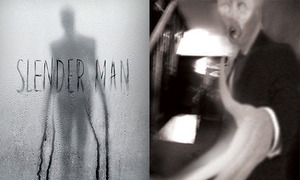The Disappointments Room: History vs. Hollywood
| REEL FACE: | REAL FACE: |
Kate Beckinsale
Born: July 26, 1973 Birthplace: Finsbury Park, London, England, UK | Laurie Dumas
Born: December 4, 1954 |
Mel Raido
Born: 1977 Birthplace: Jamaica | Jeffrey Dumas
|
Was the real disappointments room found in a once-grand southern mansion?
No. According to the true story behind the movie, the real room was discovered in a much smaller colonial style home in Rhode Island, which was built in 1857. However, it was obvious that someone wealthy had lived in the home, since it contained high-end lumber and stained glass windows. The larger home seen in the movie is the real-life Adamsleigh Mansion located in Greensboro, North Carolina. The stately mansion is not nearly as rundown in real life. The filmmakers had to spend several weeks making the home and landscaping appear unkempt.
What is a disappointments room?
As the real owner, Laurie Dumas, shared the story of her home's strange room with her coworkers at the library, a patron overheard and offered an explanation for the peculiar attic room. "A patron whispered to me, 'You have a disappointments room.'" Laurie was stunned to hear the person's explanation for the space. "Historically, these rooms were used for parents who had a child with a disability and they wanted to keep them a secret from the rest of the world," says Laurie. "So they hid them away in rooms up on their third floor, which was just unbelievable." At that time in history, some people felt there was shame attached to having a disabled or disfigured family member, so they locked them away from society.
Who had owned the real home?
The Disappointments Room true story reveals that in the late 1800s, prominent judge Job Smith Carpenter (1866 - 1906) and his wife Frances Ellen Carpenter (1871 - 1918) had owned the real home. The street that runs beside the home, Carpenter Court, was named after the judge. For the movie, the judge's name was changed to Judge Blacker (Gerald McRaney) and his wife is referred to as Mrs. Blacker (Jennifer Leigh Mann). The real home is on the local historical register and was named the Casey B. Tyler House after a prominent early resident who had lived there prior to Judge Carpenter.
Was there evidence that the real judge and his wife had a child?
Yes. After looking through a cemetery database at the library, Laurie Dumas found the location of the plot in Woodland Cemetery where Judge Carpenter (the real Judge Blacker) and his family were buried. On the side of the gravestone was a daughter's name, Ruth (1895 - 1900), "Daughter of Job S. & Frances E. Carpenter." "We felt that we had found the occupant of our sad little room," says Laurie. She scoured old newspapers for more information about the judge. There were many articles about him, but strangely, there were none announcing the February 1895 birth of his daughter, and there was only a tiny mention of her death in 1900 at age 5. "I think he might of had a very sick little girl," concludes Laurie. "Nothing about her life was mentioned, even though the rest of her family were always in the paper." Laurie believes that the politically-inclined Judge Carpenter used the disappointments room to keep his disabled daughter Ruth secret from the outside world.
Was the disappointments room discovered in the attic of the home?
Yes, but as you can see below, the front wall of the real room looks more like a doll house than a dungeon, and is made of wood, not bricks. There is a door knob on only the outside and also a deadbolt, making it nearly impossible for anyone to get out of the room. There are two windows on the far wall of the room, which are too high to safely escape from. Perhaps the most peculiar part of the real room is the floor, which is made of metal and has a drain. The disappointments room created for the movie was built on the grounds of the Adamsleigh Mansion, the home used for the movie.
Did Laurie and Jeff Dumas buy the home together?
No. Laurie Poirier, a librarian, bought the old colonial before she met her future husband, Jeffrey Dumas. (The movie has the husband and wife buying the home together when they are looking for a fresh start after marital problems.) Laurie moved into the home from an apartment around the corner, not Brooklyn. In real life, after Laurie met Jeff, she invited him to her home and he did a little exploring. He first found a child's old letter block in a small cupboard that was hidden near the ceiling in the basement. After they were married, he moved in and they began exploring the extra space that they had in the attic. "The attic was just this big, dusty old storage place," says Laurie. Jeff had hoped to use the strange, walled-off room that was at one end of the attic for his music room. "He was going to set up his equipment. Actually, he was going to put a little light up on the doorway that would light up when he was recording."
Did the real couple have a five-year-old son?
No. The real couple are never mentioned as having any children. In The Disappointments Room movie, the couple has a five-year-old son named Lucas (Duncan Joiner).
Is the real Disappointments Room house haunted?
No. The real judge, Judge Carpenter, is not haunting the home like Judge Blacker does in the movie. In fact, the real owners did not report anything at all paranormal going on inside of the Rhode Island home. To take away some of the sadness associated with the room, Laurie decorated it in what she says are "colors a little girl would appreciate." This included adding drapes, chairs, a table, and a couple dolls (which unintentionally still make it seem creepy. See Annabelle). "Ruthie has become just part of the household," says Laurie.
Do "disappointment rooms" or their equivalents still exist today?
Unfortunately, yes. For a large portion of the 20th century, it was common in the United States and Great Britain to segregate individuals with special needs from the rest of society, locking them away in institutions (or keeping them hidden in homes), with the troubling justification that it was for their own good and the good of society. Not only did many of these individuals suffer direct emotional and physical abuse in institutions, their special needs were never met, and they were denied dignity, choice, and were given little respect. Horror stories of such abuses are described in books like Forgotten Lives and Pride Against Prejudice by Jenny Morris.
More troubling is that keeping disabled children hidden still exists in various regions of the world today. In Kenya, many parents have been hiding and mistreating children with disabilities, fearing that they will bring shame to their families. As a result, there is a high mortality rate for children with disabilities because of the harsh conditions that their parents have subjected them to. After being kept indoors for years, hidden children have been found emaciated and with altered skin and hair color.
As recently as July of this year, a 22-year-old Louisiana woman with autism was kept locked in a 6-by-8-foot cage behind a mobile home for months. In 2013, a disabled 25-year-old Texas woman was found locked in a cage in the back room of a home. Blind and in a semi-fetal position, she was covered in dried fecal matter. While these sickening and unimaginable stories are the ones that become headlines, it's important to remember that less "newsworthy" instances of abuse and mistreatment are happening to the disabled every day.
HGTV Disappointments Room Segment & Related Videos
What is a disappointments room? In case you're still curious, the HGTV If Walls Could Talk "Disappointments Room" episode should help to expand your knowledge of the true story. It features the real couple who discovered the room, along with video of the room itself.
Link-to-Learn More:







